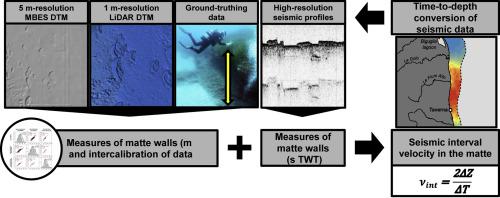Marine Environmental Research ( IF 3.3 ) Pub Date : 2020-08-06 , DOI: 10.1016/j.marenvres.2020.105085 Briac Monnier 1 , Gérard Pergent 1 , Miguel Ángel Mateo 2 , Philippe Clabaut 3 , Christine Pergent-Martini 1

|
High-resolution seismic reflection data have been used over the last decades to estimate the thickness of the long-term Blue Carbon sink associated to the below-ground sediment deposit (matte) of the Posidonia oceanica meadows. Time-to-depth conversion of these geophysical datasets was usually performed assuming a sound velocity in this structure, but appropriate seismic interval velocity measurements is necessary to achieve accurate calibration. This study describes the first methodology to estimate the seismic interval velocity in the matte. This approach performed on the eastern continental shelf of Corsica island (France, NW Mediterranean) is based on measurements of the vertical matte profile from high-resolution seismic reflection profiles (s TWTT) and from seafloor morpho-bathymetric DTM (multibeam echosounders - MBES and Light Detection and Ranging - LiDAR surveys) calibrated with ground-truthing data. A biogeosedimentological analysis of horizontal cores sampled in vertical matte escarpments has been undertaken to identify the potential relationship of sediment and environmental parameters with sound velocity. The cross-comparison and the data intercalibration show significant correlation of MBES (R2 = 0.872) and LiDAR datasets (R2 = 0.883) with direct underwater measurements. Seismic interval velocities (n = 367) have been found to range between 1 631.9 and 1 696.8 m s−1 (95% confidence interval) and are estimated on average at 1 664.4 m s−1, which is similar to the literature for unconsolidated marine sediments. The prediction map provided by the ordinary kriging method emphasized, however, a high variability of sound velocity within the study area. The results showed that changes in sound velocity in the matte are positively and strongly correlated with sand and gravel content and environmental factors such as distance to coastal river mouths and coastline. However, it was found that a negative relationship linked sound velocity with total and coarse organic content of matte deposits.
中文翻译:

大洋波西多尼亚草甸草丛中的地震间隔速度:一种无损检测方法,用于大规模评估蓝碳储量。
在过去的几十年中,已经使用高分辨率地震反射数据来估计与大洋波西多尼亚地下沉积物沉积物(无光泽)有关的长期蓝碳汇的厚度。草地。这些地球物理数据集的时间到深度的转换通常是假设结构中有声速进行的,但是需要适当的地震间隔速度测量才能实现准确的校准。这项研究描述了第一种估算遮罩地震间隔速度的方法。在科西嘉岛东部大陆架(法国,西北地中海)上进行的这种方法是基于高分辨率地震反射剖面(s TWTT)和海底形态测深DTM(多波束回声测深仪-MBES和光检测和测距-LiDAR测量)已通过地面真实数据进行了校准。已经对垂直磨砂悬崖中取样的水平岩心进行了生物地质沉积学分析,以确定沉积物和环境参数与声速之间的潜在关系。交叉比较和数据相互校准显示MBES(R2 = 0.872)和 具有直接水下测量的LiDAR数据集(R 2 = 0.883)。已发现地震间隔速度(n = 367)介于1 631.9和1 696.8 m s -1(95%置信区间)之间,平均估计为1 664.4 m s -1,类似于关于未固结海洋沉积物的文献。但是,普通克里金法提供的预测图强调了研究区域内声速的高可变性。结果表明,冰沙中声速的变化与砂砾含量和环境因素(与沿海河口和海岸线的距离)成正相关,且与环境因素呈正相关。但是,人们发现负相关关系将声速与消光沉积物的总有机含量和粗有机含量联系在一起。


























 京公网安备 11010802027423号
京公网安备 11010802027423号